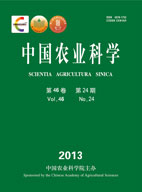-
Establishment of an Experimental Pathological Model by Using EHEC O46 Isolate in Duck
- YU Xue-Hui-1, LI Jian-2, CHENG An-Chun-3, HUANG Zhi-Hong-1, LUO Wei-1, RAN Dan-Dan-1
-
Scientia Agricultura Sinica. 2013, 46(24):
5217-5227.
doi:10.3864/j.issn.0578-1752.2013.24.016
-
 Abstract
(
412 )
Abstract
(
412 )
 PDF (1332KB)
(
574
)
PDF (1332KB)
(
574
)
 Save
Save
-
References |
Related Articles |
Metrics
【Objective】This experiment was conducted to build an experimental pathological model of EHEC O46 isolate and observe its dynamic distribution, and the dynamic changes of histopathology and ultra-structural pathology in experimentally infected ducklings.【Method】The 10-day-old ducklings were infected with 0.5 mL of O46 isolate(2×108CFU•mL-1)through oral, intramuscular and subcutaneous injection separately. Tissue samples of heart, liver, spleen, lung, kidney, cerebra, esophagus, thymus, duodenum, jejunum, cecum, rectum, bursa of fabricius, pancreas and trachea were taken from the infected ducklings after being infected for 2, 4, 6, 12, and 24 h, and ever since for every 12 hours to make tissue biopsies and ultrathin sections, which were thenstained with haematoxylin and eosin (H.E), as well as uranyl acetate, lead citrate and immunohistochemistry to observe the changes of histopathology, ultra-structural pathology and the bacterial antigen localization in experimentally infected ducklings. 【Result】 Same clinical symptoms as with naturally infected cases were duplicated in experimental pathological model. Bacterial antigens were detected in different tissues except trachea. The target tissues were hearts, lungs, spleens, kidneys and intestinal tracts where bacterial antigen located in cytoplasm and the positive signals were found in heart firstly. Necropsy, histopathological changes and ultra-structural pathological changes showed that main pathological damages of EHEC O46 isolate in ducklings were as follows:serous generalized fibrinous inflammation could be seen; hyperemia, hemorrhage and inflammatory cell infiltration were presented in heart, liver, spleen, lung, kidney, bursa of fabricius, intestinum tenue, pancreas and cerebrum; histopathological changes of necrosis and apoptosis were displayed in parenchyma cell such as renal tubular epithelial cell, hepatocyte, cardiomyocyte and enterocyte; reduction of lymphocytes could be seen in bursa of fabricius. E.coli was observed in heart, lung, spleen, liver, and intestinum tenue by SEM. The target tissue cells where isolate located were lymphocytes, macrophages, enterocytes and cardiac fibroblasts. 【Conclusion】 EHEC O46 isolate in duck showed high pathogenicity in ducklings. Pathologcial changes such as hemorrhagic enteritis and hemolytic uremic syndrome caused by EHEC were duplicated in experimental pathological model. It was concluded that O46 isolate was the pantropic bacteria injuring most tissues and cells in ducklings, and the principal target organs were heart, lung, spleen, kidney and intestine.









